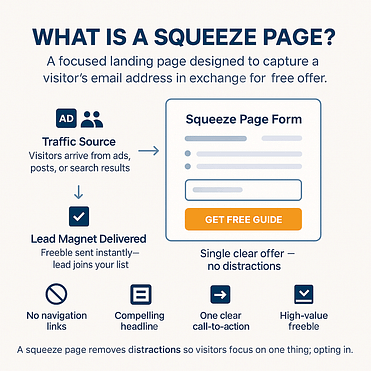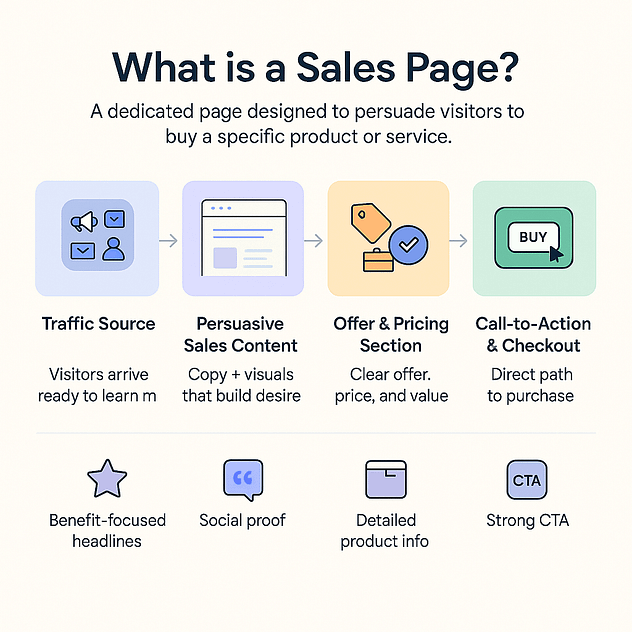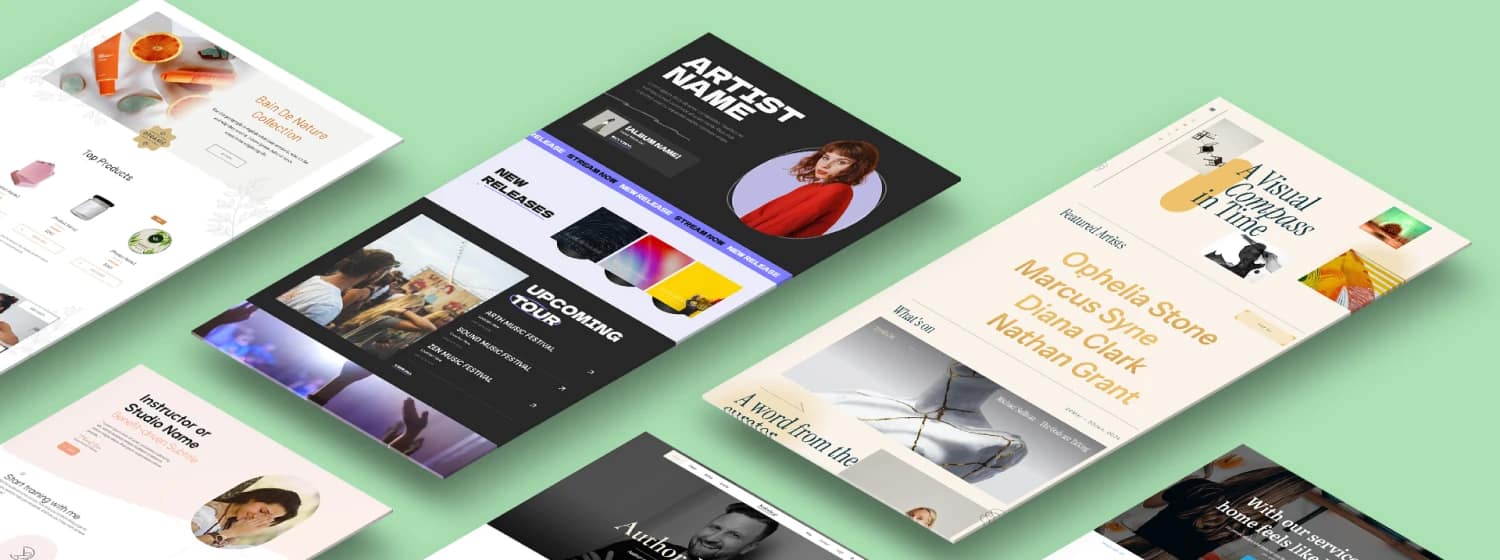TL;DR: Squeeze Page vs. Sales Page: What You Need to Know
Squeeze pages are for collecting leads (usually an email).
→ Use them at the top of your funnel to offer a freebie, quiz, or registration in exchange for contact info.
→ Keep it short, focused, and free of distractions. One goal, one CTA.Sales pages are for making sales.
→ Use them with warm leads who already know, like, or trust you.
→ Include detailed copy, social proof, and multiple CTAs — all driving to the same conversion.Don’t confuse the two:
→ A squeeze page won’t sell a product.
→ A sales page won’t work with cold traffic.Yes, you can combine them — just do it intentionally.
→ Use a 2-step opt-in, or start with a freebie and follow up with a sales pitch via email.
Pro tip: Let each page do its job — and connect them inside a smart funnel.
Are You Sure You’re Using the Right Type of Page?
It’s easy to assume a landing page is just… a landing page.
You build one, set a goal, and hit publish. But if you’ve ever struggled to get the conversions you were hoping for, there’s a good chance the issue wasn’t your design – it was the type of page you used.
A squeeze page and a sales page might look similar, but they serve completely different purposes. One is built to capture leads. The other is designed to close a sale. Using the wrong one – or using them out of order – can quietly stall your funnel and cost you results.
This guide is here to help you get it right. You’ll learn when to use each type of page, how to structure them effectively, and where a hybrid approach might make sense.
Because it’s not just about having a page that looks good. It’s about building with intention — and choosing the right tool for the job.
What Is a Squeeze Page? (The Lead Catcher)
A squeeze page is a focused landing page with one job: to collect contact information — usually just an email address — in exchange for something valuable. That’s it. No distractions, no deep dive, no sales pitch.
The goal isn’t to sell. It’s to start a relationship.

You’re offering value upfront — a helpful guide, a discount, a webinar invite, a quiz result — and in return, the visitor gives you permission to stay in touch. It’s the digital equivalent of saying, “Hey, I’ve got something useful for you. Want it?”
The Core Purpose of a Squeeze Page
- Capture an email address (or minimal info)
- Open the door to a longer conversation
- Move cold traffic one step closer to trust
When done right, a squeeze page feels like a favor, not a transaction. You’re solving a small but real problem for the visitor — and setting the stage for deeper engagement later.
What Are the Key Elements of a High-Converting Squeeze Page?
A good squeeze page is clean, simple, and clear.
Here’s what makes it work:
- A magnetic lead magnet — Think: guides, checklists, templates, discounts, mini-courses, quizzes. It should speak directly to a pain point or curiosity.
- Minimalist layout — Strip away navigation, footers, sidebars. If it doesn’t support the opt-in, it doesn’t belong.
- Short, value-focused copy — What are they getting? Why should they care? Keep it tight, benefit-driven, and skimmable.
- One goal, one form, one action — No competing CTAs. Just one thing to do.
- Clear, benefit-led button — Avoid generic “Submit” buttons. Use something like “Get the Free Guide” or “Send Me the Discount” instead.
This is where tools like Thrive Architect really shine — you can build and test high-converting squeeze pages quickly, without fighting your theme or code. Ready to build your first one? Grab Thrive Architect and get started in minutes.
When to Use a Squeeze Page?
Squeeze pages are ideal at the top of your funnel — when someone is just discovering you, and you want to invite them in.
- Launching a list-building campaign
- Running ads to a freebie, quiz, or webinar
- Testing interest in a new niche or idea
- Segmenting your audience before sending them sales content
It’s a small ask that creates a valuable moment of commitment — and lays the groundwork for everything that comes next.
📌 Want to go deeper into list building?
Check out our full guide to building an email list that actually converts. It covers smart lead magnet ideas, list segmentation tips, and how to turn new subscribers into future buyers — all using the tools you already have.
What Is a Sales Page? (The Deal Closer)
A sales page is where you stop nurturing and start selling.
Unlike a squeeze page, which asks for a small commitment, a sales page asks for the real one — a purchase, a sign-up, a decision. That means it needs to work harder. It has to build trust, answer objections, explain value, and make it incredibly easy to say yes.

This is where all the work you've done leading up to this point pays off.
The Core Purpose of a Sales Page
- Turn warm leads into customers
- Communicate the full value of your offer
- Make buying feel like the obvious next step
A sales page isn't about pushing harder — it's about presenting your offer clearly and confidently. The best ones guide readers through a logical, emotional, and friction-free journey to “I’m in.”
What Are the Key Elements of a High-Converting Sales Page?
Every section has a job. The structure isn’t random — it’s built to reduce doubt, increase desire, and nudge the reader toward action.
- A compelling headline + offer stack — Lead with clarity, not cleverness. Your headline should tell them what they’ll gain, not just what you’re selling.
- Emotional storytelling + solution-driven logic — Describe the problem, relate to their experience, and position your product as the clear solution.
- Detailed product breakdown — What they get, how it works, why it matters. Transparency builds trust.
- Strong social proof — Testimonials, recognizable logos, endorsements, money-back guarantees. This isn’t a bonus — it’s a requirement.
- Multiple CTAs — Spread throughout the page, but all pointing to one action: buy, enroll, or sign up.
⚙️ Pro tip: This is where Thrive Architect and Thrive Optimize shine — create, split test, and refine every section to find what actually moves the needle.
When to Use a Sales Page?
Sales pages are most effective when your audience already knows, likes, and trusts you — or at least understands the problem you solve.
Use one when you’re:
Whether it’s the final step in a funnel or a standalone campaign, your sales page should carry the weight of your offer — and make the outcome feel worth every click.
Pro Tip: Looking for how to build the right kind of sales page immediately? Check out this detailed sales page strategy guide.
Squeeze Page vs. Sales Page: Quick Comparison
Still unsure which one you need? Here’s a side-by-side breakdown to make the choice easier. If you’re clear on your goal, the right page almost picks itself.
Squeeze Page vs. Sales Page
Feature | Squeeze Page | Sales Page |
|---|---|---|
Goal | Capture an email | Make a sale |
Audience | Cold or first-time visitors | Warm leads, already familiar with you |
Length | Very short (1–2 folds) | Long-form, often multiple sections |
Primary CTA | Opt-in, download, get access | Buy now, enroll, sign up |
Design | Minimalist, single purpose | Persuasive, detail-rich, trust-oriented |
Best Use Case | Lead magnets, quizzes, top-of-funnel ads | Selling products, courses, services |
✅ Need both? Start with a squeeze page to capture interest, then guide leads to a sales page once they’re ready.
Can You Combine a Sales Page and a Squeeze Page? (The Hybrid Approach)
Sometimes, the right move isn’t choosing between a squeeze page and a sales page — it’s using both, together, in the right sequence.
This hybrid approach can work beautifully if it’s intentional. Done well, it gives you the best of both worlds: lead generation and conversion.
When You Should Use Both a Sales Page and a Squeeze Page
There are a few smart ways to combine squeeze-style lead capture with a sales pitch — without confusing your visitor:
- Use a 2-step opt-in: Instead of showing the form immediately, use a CTA button that reveals the form after a click. This micro-commitment increases conversions and keeps the page clean. Thrive Architect makes this effortless.
- Lead with value: Offer a freebie or low-barrier lead magnet first (e.g. a checklist, quiz result, or webinar invite), and then transition into the pitch. This is a core part of building a powerful quiz funnel and is one of the most effective lead generation tactics you can use.
- Great for tripwires and webinars: These funnels often start with a quick opt-in and flow into a sales pitch once trust is established.
When You Should NOT Combine a Sales Page and a Squeeze Page
Hybrid pages can backfire when the intent gets muddled — especially with cold traffic or higher-ticket offers.
- Too much, too soon: Asking someone to opt in and make a purchase on their first visit can feel pushy or confusing.
- Mixed messaging: If the page tries to do everything at once, visitors won’t know what action to take — and they’ll likely take none.
- Lack of clarity = lost conversions: Every page needs a primary goal. If you don’t know what that is, your visitor definitely won’t.
💡 Conversion-Obsessed Tip:
If you’re not sure they’re ready to buy, don’t sell — yet. Build your list first, nurture with automated emails, and drop the sales page once they’re primed. That’s how high-converting funnels actually work.
Real Funnel Examples (Bring the Strategy to Life)
Understanding the difference between squeeze pages and sales pages is one thing — knowing how to use them together in a real funnel is where it all clicks. These examples show how the two page types work in sequence to guide visitors from curiosity to conversion.
Example 1: Free Guide → Email Series → Sales Page
Perfect for info products, coaches, and course creators
- TOFU: A squeeze page offers a valuable free guide
- MOFU: An automated email series nurtures the lead and builds trust
- BOFU: A sales page presents the full product or program with urgency
🎯 Why it works: You’re not rushing the sale. You’re meeting the visitor where they are — then warming them up for the offer.
Not sure how to build your funnels according to where your website visitors are at? Check out this detailed guide on the buyer’s journey to help you get a better understanding.
Example 2: Webinar Registration → Sales Page
Great for SaaS, consulting, or service-based businesses
- Squeeze page: Registers the visitor for a live or automated webinar
- Sales page: Follows up with the full offer, typically after the event or in the replay window
🎯 Why it works: The webinar delivers value, builds authority, and sets the stage for a smooth sales transition.
And if you want to learn more about building a webinar funnel to get the ball rolling, check out this step-by-step guide.
Example 3: Paid Ad → Quiz Funnel → Sales Page
Smart segmentation for ecommerce, coaches, and productized services
- Squeeze page: Starts with a quiz and captures an email before showing results
- Sales page: Delivers a personalized pitch based on quiz answers
🎯 Why it works: The quiz pre-qualifies the lead and creates relevance. The sales page picks up where the quiz leaves off, feeling hyper-targeted and timely.
📌 Want to build this? Thrive Quiz Builder + Thrive Architect = seamless funnel, no code needed.
And we have a quiz funnel building tutorial right here.
Frequently Asked Questions about Squeeze Pages and Sales Pages
A squeeze page is built to collect contact info (usually an email) and offer a free resource. A sales page is designed to make a direct sale — typically with more detailed copy, trust elements, and multiple CTAs.
Yes — and often, you should. Many funnels start with a squeeze page to capture leads, then move to a sales page after some nurturing via email or a webinar.
Short. One to two folds at most. The goal is to keep focus on the opt-in, with no distractions or excessive content.
Top-of-funnel content, paid ads, social media bios, YouTube video descriptions, and quizzes are all strong entry points — especially when paired with a lead magnet.
Absolutely. Even small changes (headline, CTA, layout) can lead to big conversion lifts. Thrive Optimize makes it easy to test variations directly on your WordPress site.
Conclusion: Get Clear on the Goal, and Build From There
The difference between a squeeze page and a sales page isn’t just about length or layout — it’s about purpose.
- If your goal is to grow your list, use a squeeze page.
- If your goal is to make a sale, use a sales page.
- If you want to do both, map the full journey — and let each page play its part.
The most effective funnels don’t try to do everything at once. They guide visitors step by step, with each page designed for a single, strategic action.
And the best part? You don’t need to overthink the tech. With tools like Thrive Architect, you can build both types of pages in minutes — and connect them into a seamless, conversion-driven funnel that grows with your business.
📌 Explore more in our Guide to Landing Pages.


